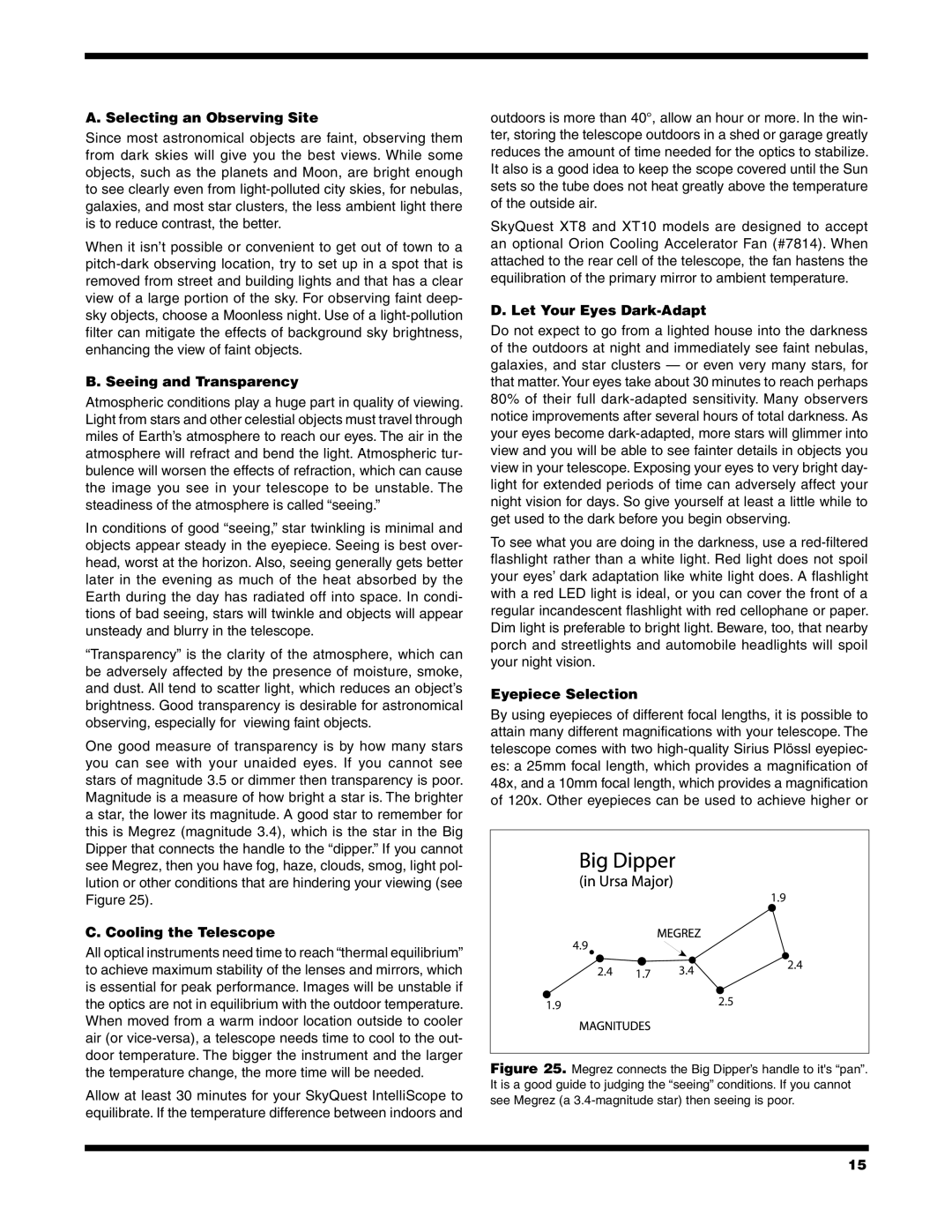
A. Selecting an Observing Site
Since most astronomical objects are faint, observing them from dark skies will give you the best views. While some objects, such as the planets and Moon, are bright enough to see clearly even from
When it isn’t possible or convenient to get out of town to a
B. Seeing and Transparency
Atmospheric conditions play a huge part in quality of viewing. Light from stars and other celestial objects must travel through miles of Earth’s atmosphere to reach our eyes. The air in the atmosphere will refract and bend the light. Atmospheric tur- bulence will worsen the effects of refraction, which can cause the image you see in your telescope to be unstable. The steadiness of the atmosphere is called “seeing.”
In conditions of good “seeing,” star twinkling is minimal and objects appear steady in the eyepiece. Seeing is best over- head, worst at the horizon. Also, seeing generally gets better later in the evening as much of the heat absorbed by the Earth during the day has radiated off into space. In condi- tions of bad seeing, stars will twinkle and objects will appear unsteady and blurry in the telescope.
“Transparency” is the clarity of the atmosphere, which can be adversely affected by the presence of moisture, smoke, and dust. All tend to scatter light, which reduces an object’s brightness. Good transparency is desirable for astronomical observing, especially for viewing faint objects.
One good measure of transparency is by how many stars you can see with your unaided eyes. If you cannot see stars of magnitude 3.5 or dimmer then transparency is poor. Magnitude is a measure of how bright a star is. The brighter a star, the lower its magnitude. A good star to remember for this is Megrez (magnitude 3.4), which is the star in the Big Dipper that connects the handle to the “dipper.” If you cannot see Megrez, then you have fog, haze, clouds, smog, light pol- lution or other conditions that are hindering your viewing (see
outdoors is more than 40°, allow an hour or more. In the win- ter, storing the telescope outdoors in a shed or garage greatly reduces the amount of time needed for the optics to stabilize. It also is a good idea to keep the scope covered until the Sun sets so the tube does not heat greatly above the temperature of the outside air.
SkyQuest XT8 and XT10 models are designed to accept an optional Orion Cooling Accelerator Fan (#7814). When attached to the rear cell of the telescope, the fan hastens the equilibration of the primary mirror to ambient temperature.
D. Let Your Eyes Dark-Adapt
Do not expect to go from a lighted house into the darkness of the outdoors at night and immediately see faint nebulas, galaxies, and star clusters — or even very many stars, for that matter.Your eyes take about 30 minutes to reach perhaps 80% of their full
To see what you are doing in the darkness, use a
Eyepiece Selection
By using eyepieces of different focal lengths, it is possible to attain many different magnifications with your telescope. The telescope comes with two
Figure 25).
C. Cooling the Telescope
All optical instruments need time to reach “thermal equilibrium” to achieve maximum stability of the lenses and mirrors, which is essential for peak performance. Images will be unstable if the optics are not in equilibrium with the outdoor temperature. When moved from a warm indoor location outside to cooler air (or
4.9
2.4 | 1.7 |
1.9
1.9
3.4 | 2.4 |
|
2.5
the temperature change, the more time will be needed.
Allow at least 30 minutes for your SkyQuest IntelliScope to equilibrate. If the temperature difference between indoors and
Figure 25. Megrez connects the Big Dipper’s handle to it's “pan”. It is a good guide to judging the “seeing” conditions. If you cannot see Megrez (a 3.4-magnitude star) then seeing is poor.
15
